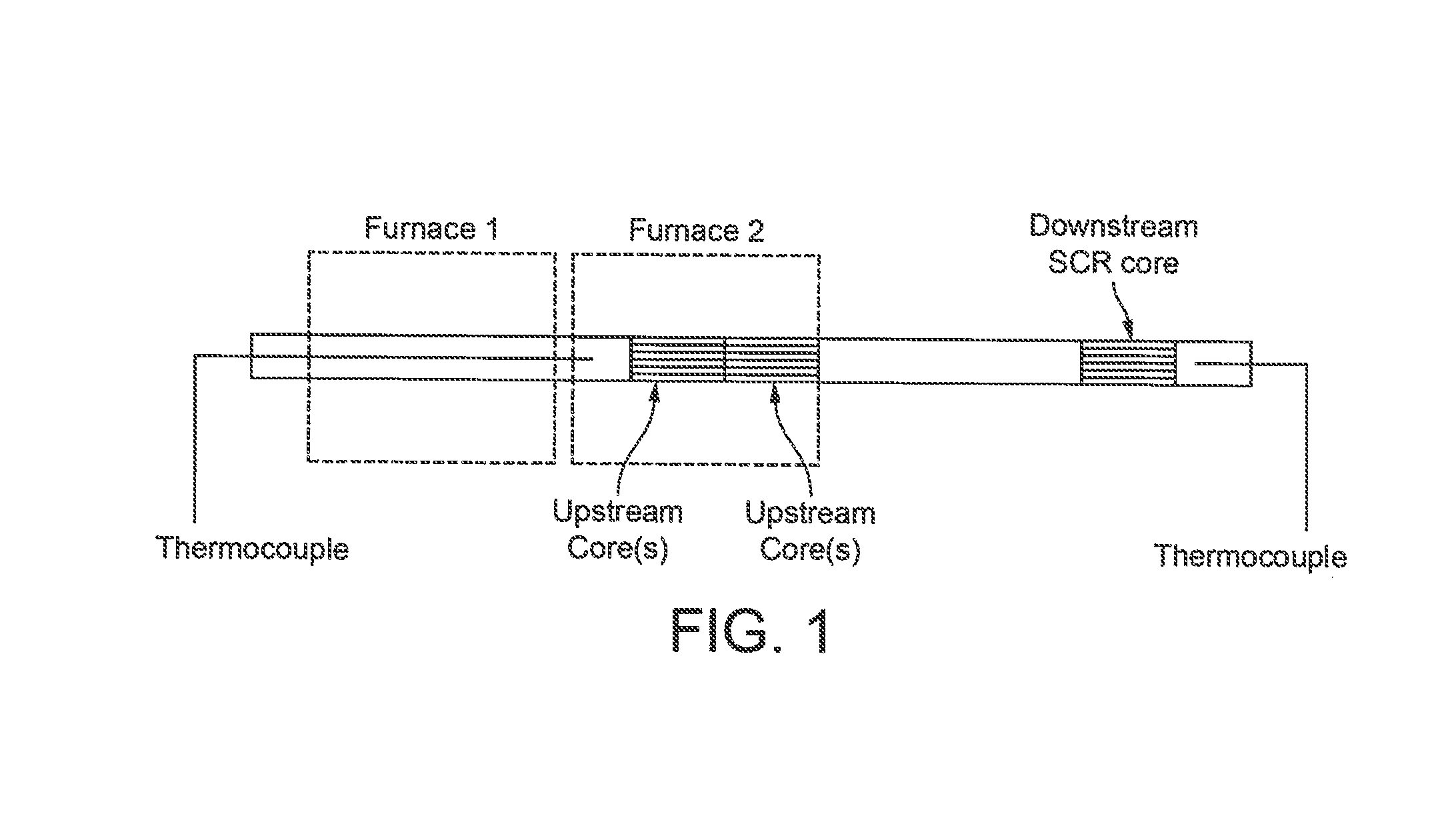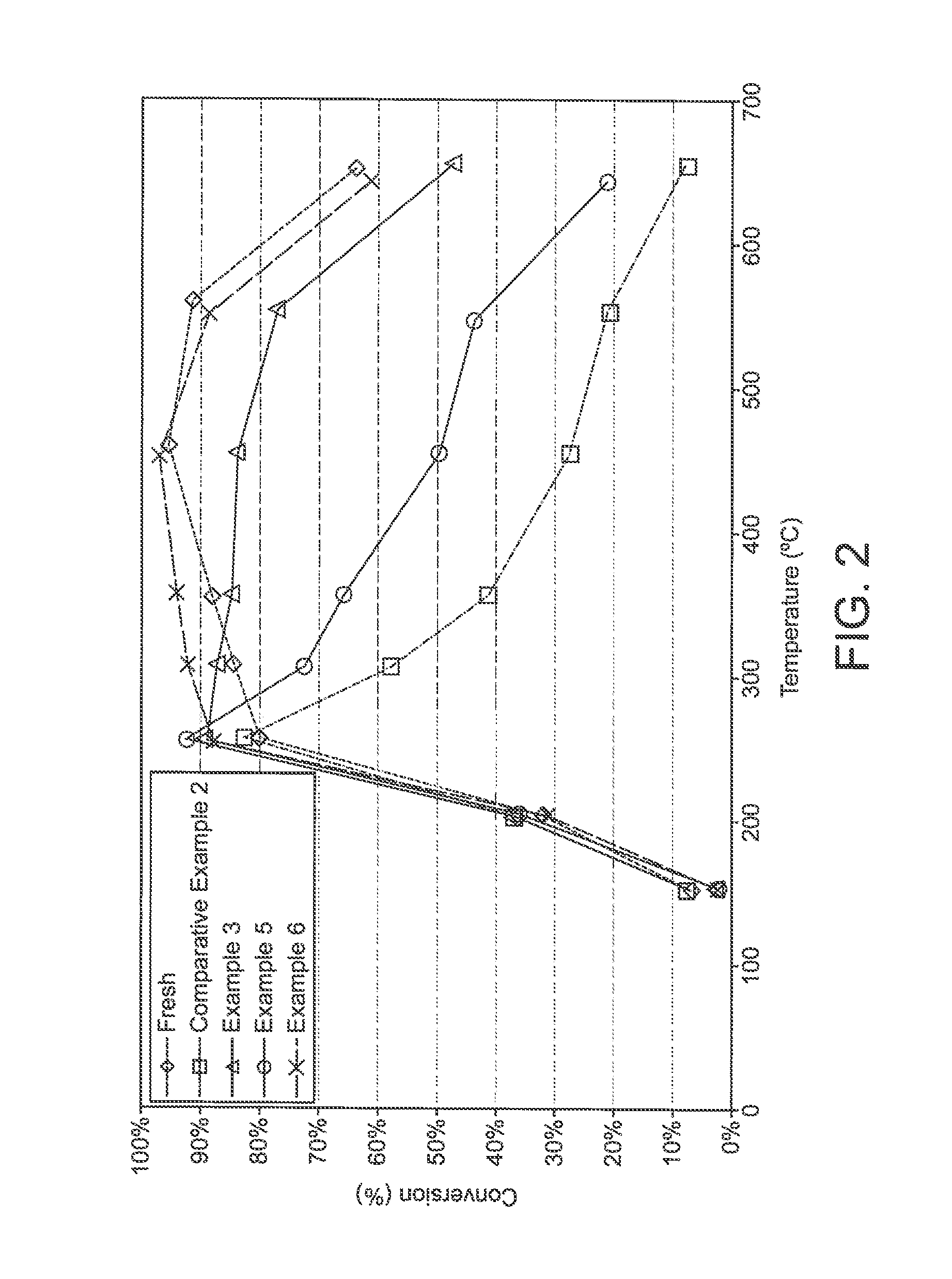Catalysed substrate monolith
a substrate monolith and catalyst technology, applied in the direction of metal/metal-oxide/metal-hydroxide catalysts, machines/engines, arsenic compounds, etc., can solve the problems of uncontrollable or poorly controlled regeneration events, unintended engine upset,
- Summary
- Abstract
- Description
- Claims
- Application Information
AI Technical Summary
Benefits of technology
Problems solved by technology
Method used
Image
Examples
example 1
Preparation of Substrate Monolith Coated with 5 wt % Fe / Beta Zeolite
[0089]Commercially available Beta zeolite was added to an aqueous solution of Fe(NO3)3 with stirring. After mixing, binders and rheology modifiers were added to form a washcoat composition.
[0090]A 400 cells per square inch (cpsi) cordierite flow-through substrate monolith was coated with an aqueous slurry of the 5 wt % Fe / Beta zeolite sample using the method disclosed in Applicant / Assignee's WO 99 / 47260, i.e. comprising the steps of (a) locating a containment means on top of a support, (b) dosing a pre-determined quantity of a liquid component into said containment means, either in the order (a) then (b) or (b) then (a), and (c) by applying pressure or vacuum, drawing said liquid component into at least a portion of the support, and retaining substantially all of said quantity within the support. This coated product (coated from one end only) is dried and then calcined and this process is repeated from the other end...
example 3
Preparation of Pt-Inlet / Pd-Outlet Containing Catalysed Wall-Flow Filter
[0093]A coated filter was prepared using the same method as in Comparative Example 2, except in that 100% of the total channel length of channels intended for orientation towards the inlet side of gas contact was coated with a washcoat containing platinum nitrate and alumina before the coated filter was dried; and 35% of the total length of channels of the Pt-coated filter intended for orientation towards the outlet side were coated with a washcoat containing palladium nitrate and alumina. The resulting fully coated filter was then dried, then calcined. The total loading of Pt on the coated filter was 5 gft−3 and the total loading of Pd on the coated filter was 1.75 gft−3.
[0094]A core of 1 inch (2.54 cm) diameter×3 inches long was cut from the finished article. The resulting part is described as “fresh”, i.e. unaged.
example 4
Preparation of Pt-Inlet / Al2O3-Outlet Containing Catalysed Wall-Flow Filter
[0095]A coated filter was prepared using the same method as Example 3, except in that 35% of the total length of channels intended for orientation towards the outlet side were coated with a washcoat containing alumina only. The resulting coated filter was then dried, then calcined. The total loading of Pt on inlet channels of the coated filter was 5 gft−3.
[0096]A core of 1 inch (2.54 cm) diameter×3 inches long was cut from the finished article. The resulting part is described as “fresh”, i.e. unaged.
PUM
| Property | Measurement | Unit |
|---|---|---|
| temperatures | aaaaa | aaaaa |
| temperature | aaaaa | aaaaa |
| temperatures | aaaaa | aaaaa |
Abstract
Description
Claims
Application Information
 Login to View More
Login to View More - R&D
- Intellectual Property
- Life Sciences
- Materials
- Tech Scout
- Unparalleled Data Quality
- Higher Quality Content
- 60% Fewer Hallucinations
Browse by: Latest US Patents, China's latest patents, Technical Efficacy Thesaurus, Application Domain, Technology Topic, Popular Technical Reports.
© 2025 PatSnap. All rights reserved.Legal|Privacy policy|Modern Slavery Act Transparency Statement|Sitemap|About US| Contact US: help@patsnap.com



